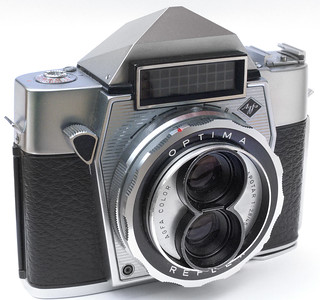Difference between revisions of "Agfa Optima Reflex"
(stub with new pool photo) |
Hanskerensky (talk | contribs) (Added Category:O) |
||
| (8 intermediate revisions by 6 users not shown) | |||
| Line 1: | Line 1: | ||
| − | {{ | + | {{German_TLR |
| − | |image_source= | + | |image_source= https://www.flickr.com/photos/14463685@N07/9577742576/in/pool-camerawiki/ |
| − | |image= | + | |image= https://live.staticflickr.com/5447/9577742576_32f0b9d2fe_n.jpg |
|image_align= right | |image_align= right | ||
| − | |image_text= Agfa Optima Reflex | + | |image_text= Agfa Optima Reflex (1965) |
| − | |image_by= | + | |image_by= Howard Somerville |
| − | |image_rights= with permission | + | |image_rights= with permission |
}} | }} | ||
| − | + | The '''Optima Reflex''' (also sold in some countries as the '''Agfamatic Reflex''') is a 35 mm [[TLR]] camera made by [[Agfa]] from 1961-66.<ref name=McK>{{McKeown12}} p30.</ref> It is extremely unusual in that it is a twin-lens reflex camera fitted with a permanent pentaprism viewfinder. Pentaprism viewfinders were available as accessories for other twin-lens reflex cameras such as the Rolleiflex, but it is unusual to find a TLR with a permanent pentaprism viewfinder. | |
| − | + | ||
| + | The Optima Reflex is a revised version of the [[Agfa Flexilette|Flexilette]], with an eye-level [[pentaprism]] viewfinder instead of a waist-level finder, and with a selenium lightmeter supporting a fully automatic exposure mechanism. The aperture and shutter speed selector dials of the Flexilette were deleted for the Optima Reflex. McKeown states that this automatic exposure mechanism is designed to favour fast shutter speeds at the expense of aperture.<ref name=McK/> | ||
| + | |||
| + | The camera has coated Color Apotar 45mm f/2.8 lenses, and a Prontor shutter with speeds 1/30 - 1/250 second, plus 'B'. Close focus is approximately 3 feet. The camera supports X-synch flash units. The film transport carries unexposed film from the right side of the camera to the left (photographer's viewpoint), and the single-stroke film advance lever is on the bottom of the camera body. An accessory embossed leather case was available.<ref>Brooks Cameras Directory, 1965</ref> | ||
| + | |||
| + | |||
| + | ==Notes== | ||
| + | <references/> | ||
| + | == Links == | ||
| + | * [https://www.butkus.org/chinon/agfa/agfa_optima_reflex/agfa_optima_reflex.htm Agfa Optima Reflex PDF manual] at [https://www.butkus.org/chinon/index.html OrphanCameras.com] | ||
| + | |||
| + | |||
| + | [[Category: 35mm TLR]] | ||
| + | [[Category: 1961]] | ||
| + | [[Category:Agfa|Optima Reflex]] | ||
| + | [[Category:O|Optima Reflex Agfa]] | ||
Latest revision as of 04:04, 4 September 2023
| |||
| German TLR () | |||
|---|---|---|---|
| 35 mm | Contaflex | Flexilette | Optima Reflex | ||
| 3×4 | Pilot Reflex | ||
| 4×4 | Baby Rolleiflex (1931) | Baby Rolleiflex (1957) | Karma-Flex | ||
| 6×6 | Altiflex | Amplion Reflex | Brillant | Flektar | Flexo | Flexora | Flexora II | Flexora III | Foth-Flex | Ikoflex 1 | Ikoflex II | Ikoflex Ia | Ikoflex Ic Ikoflex Favorit | Karma-Flex | Mentorett | Montiflex | Peerflekta | Perfekta | Photina Reflex | Plascaflex | Reflecta | Reflekta | Reflekta II | Rica Flex | Rocca Automatic | Rocca Super Reflex | Rolleiflex | Rolleicord | Rollop | Superb | Superflex | Trumpfreflex | Vitaflex | Weltaflex | Wirgin Reflex | Zeca-Flex | ||
| 6×9 | Superfekta | ||
The Optima Reflex (also sold in some countries as the Agfamatic Reflex) is a 35 mm TLR camera made by Agfa from 1961-66.[1] It is extremely unusual in that it is a twin-lens reflex camera fitted with a permanent pentaprism viewfinder. Pentaprism viewfinders were available as accessories for other twin-lens reflex cameras such as the Rolleiflex, but it is unusual to find a TLR with a permanent pentaprism viewfinder.
The Optima Reflex is a revised version of the Flexilette, with an eye-level pentaprism viewfinder instead of a waist-level finder, and with a selenium lightmeter supporting a fully automatic exposure mechanism. The aperture and shutter speed selector dials of the Flexilette were deleted for the Optima Reflex. McKeown states that this automatic exposure mechanism is designed to favour fast shutter speeds at the expense of aperture.[1]
The camera has coated Color Apotar 45mm f/2.8 lenses, and a Prontor shutter with speeds 1/30 - 1/250 second, plus 'B'. Close focus is approximately 3 feet. The camera supports X-synch flash units. The film transport carries unexposed film from the right side of the camera to the left (photographer's viewpoint), and the single-stroke film advance lever is on the bottom of the camera body. An accessory embossed leather case was available.[2]
Notes
- ↑ 1.0 1.1 McKeown, James M. and Joan C. McKeown's Price Guide to Antique and Classic Cameras, 12th Edition, 2005-2006. USA, Centennial Photo Service, 2004. ISBN 0-931838-40-1 (hardcover). ISBN 0-931838-41-X (softcover). p30.
- ↑ Brooks Cameras Directory, 1965
